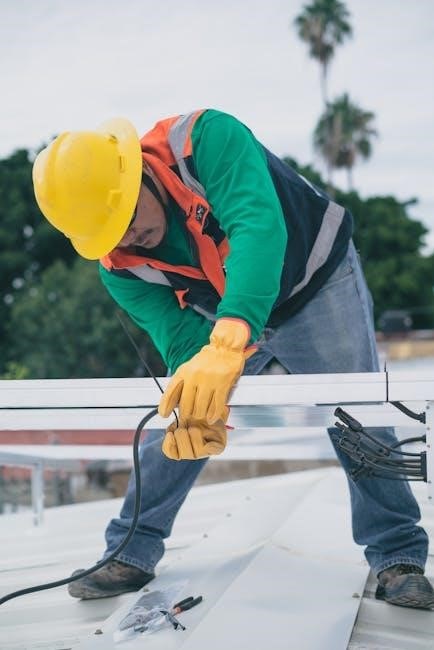givenergy all in one installation manual
The GivEnergy All in One System is a comprehensive energy storage solution‚ combining an inverter and gateway for seamless energy management. Designed for efficiency and ease‚ it supports residential and commercial applications‚ offering scalable and intelligent energy storage. This system integrates with smart technology‚ ensuring optimal performance and future-proof energy management.

1.1 Overview of the GivEnergy All in One System
The GivEnergy All in One System is a fully integrated energy storage solution designed for residential and commercial applications. It combines a high-efficiency inverter‚ advanced battery management‚ and smart grid connectivity into a single‚ compact unit. This system is optimized for solar energy storage‚ offering seamless integration with existing electrical systems. The All in One System is designed to maximize energy efficiency‚ reduce grid reliance‚ and provide backup power during outages. With its user-friendly interface and remote monitoring capabilities‚ it ensures optimal performance and adaptability to varying energy demands. The system is scalable‚ making it suitable for a wide range of energy needs.
1.2 Key Features and Benefits
The GivEnergy All in One System offers numerous features‚ including a high-efficiency inverter‚ advanced battery management‚ and seamless smart grid integration. It provides backup power during outages and optimizes energy use through smart technology. The system is scalable‚ catering to various energy needs‚ and its compact design simplifies installation. Remote monitoring and user-friendly controls enhance user experience‚ while its compatibility with solar systems maximizes renewable energy utilization. These features ensure reliability‚ efficiency‚ and cost savings‚ making it a versatile solution for both residential and commercial energy storage requirements.

Pre-Installation Requirements
Installation must be performed by a GivEnergy-approved installer‚ adhering to local wiring regulations and IEE standards to ensure compliance and safety before system deployment begins.

2.1 Approved Installer Certification
Installation of the GivEnergy All in One System must be carried out by a certified GivEnergy Approved Installer. This certification ensures installers are fully trained in the specific requirements of the system‚ including electrical connections‚ communication setup‚ and compliance with local wiring regulations. Proper certification guarantees that the installation meets safety standards and system performance expectations. Installers must have completed GivEnergy’s training program and hold valid certification to proceed with any installation. This ensures reliability‚ efficiency‚ and adherence to manufacturer guidelines.
2.2 Compliance with Local Wiring Regulations
Ensuring compliance with local wiring regulations is critical for a safe and legal installation of the GivEnergy All in One System. Installations must adhere to the IEE Wiring Regulations and any additional regional requirements. Non-compliance can result in safety hazards‚ system malfunctions‚ or legal consequences. Approved installers must verify all electrical connections meet these standards before proceeding. Compliance ensures the system operates efficiently and safely‚ while also protecting against potential liabilities. Always consult local authorities for specific requirements prior to installation to guarantee full adherence to regulatory standards.
2.3 Tools and Equipment Needed
The installation of the GivEnergy All in One System requires specific tools and equipment to ensure a safe and successful process. Essential items include a multimeter for electrical measurements‚ screwdrivers (both flathead and Phillips)‚ and wire strippers for cable preparation. Additionally‚ a communication cable and appropriate connectors are necessary for system integration. Approved installers must also have access to personal protective equipment (PPE) such as gloves and safety glasses. Ensure all tools meet industry standards and are suitable for the electrical work involved. Using the correct equipment is crucial to maintain system performance and comply with safety regulations.

System Components
The GivEnergy All in One System includes a bidirectional inverter‚ Giv-Gateway for communication‚ and essential communication cables. These components work together to manage energy storage and grid interaction efficiently.
3;1 GivEnergy All in One Inverter
The GivEnergy All in One Inverter is a high-efficiency‚ bidirectional component designed to manage energy flow between the grid‚ battery‚ and electrical systems. With a power capacity of up to 6.0kW‚ it ensures seamless operation during grid outages and optimizes energy storage. This inverter is compact and integrates advanced smart technology for real-time monitoring and control. It supports both grid-tied and off-grid configurations‚ making it versatile for various energy needs. The inverter is a critical component of the All in One System‚ enabling efficient energy management and ensuring compliance with safety and performance standards.
3.2 Giv-Gateway Overview
The Giv-Gateway is a central communication hub designed to integrate seamlessly with the GivEnergy All in One System. It facilitates data exchange between the inverter‚ battery‚ and external devices‚ ensuring efficient energy management. The gateway supports both wired and wireless communication‚ enabling remote monitoring and control of the system. It plays a crucial role in optimizing energy usage‚ grid interaction‚ and system performance. The Giv-Gateway is essential for real-time monitoring‚ smart grid compatibility‚ and ensuring the system operates harmoniously with external energy sources. Its advanced connectivity features make it a vital component for modern energy storage solutions.
3.3 Communication Cable Requirements
Communication cables are essential for connecting components in the GivEnergy All in One System; Use high-quality‚ shielded CAT5e or CAT6 cables to ensure reliable data transmission. The Giv-Gateway connects to the inverter via an RJ45 port‚ and additional devices may require specific wiring configurations. Proper cable routing and termination are critical to avoid signal interference and ensure system stability; Follow the installation manual’s wiring diagrams to connect communication ports correctly. Incorrect or damaged cables can lead to communication failures‚ affecting system performance and monitoring capabilities. Always use cables approved by GivEnergy to maintain compatibility and functionality.

Installation Process
The GivEnergy All in One System installation involves mounting‚ connecting electrical components‚ and configuring communication settings. Follow the manual for a seamless and efficient setup process.
4.1 Mounting the All in One System
Mounting the GivEnergy All in One System requires careful planning and adherence to safety guidelines. Ensure the system is installed by a GivEnergy Approved Installer to guarantee compliance with local regulations. Begin by selecting a suitable location with adequate ventilation and accessibility. Use the provided mounting bracket to secure the system firmly to the wall or floor‚ ensuring it is level and stable. Double-check all connections and ensure the system is properly grounded. Follow the installation manual for specific mounting instructions to ensure optimal performance and safety. Proper mounting is essential for reliable operation and longevity of the system.
4.2 Connecting Electrical Components
Connecting electrical components of the GivEnergy All in One System requires precision and adherence to safety protocols. Begin by ensuring the power supply is turned off before initiating any connections. Connect the inverter to the battery using the appropriate cables‚ ensuring polarity is correct. Next‚ link the inverter to the grid connection point‚ following the wiring diagram provided in the manual. Use a multimeter to verify all connections are secure and functioning properly. Finally‚ connect the communication cable to the Giv-Gateway to enable system monitoring and control. Always follow the manufacturer’s guidelines to ensure safe and efficient installation. Proper electrical connections are critical for system performance and safety.
4.3 Configuring Communication Settings
After connecting the electrical components‚ configure the communication settings to ensure proper system operation. Power on the GivEnergy All in One System and connect to the Giv-Gateway using a computer or tablet. Open a web browser and navigate to the gateway’s default IP address. Log in using the admin credentials provided in the manual. Configure the network settings‚ selecting either DHCP or a static IP address. Assign a static IP if required for stability. Save the configuration and test communication by pinging the gateway or using GivEnergy’s monitoring software. Ensure all components are reachable and functioning correctly for optimal system performance and remote monitoring capabilities.

Commissioning and Testing
Commissioning involves powering up the system and performing initial checks. Ensure all components are operational‚ test communication connectivity‚ and verify electrical connections for proper functionality.
5.1 Power-Up and Initial System Check
Power-up the GivEnergy All in One System by connecting it to the electrical supply. Ensure all components are properly connected and configured. Turn on the main power supply and check for LED indicators showing normal operation. Perform an initial system self-test to verify functionality. Review communication connectivity between the inverter and gateway. Ensure electrical connections are secure and meet safety standards. If any issues arise‚ refer to the troubleshooting guide. Once the system confirms operational readiness‚ proceed to configure additional settings as required.
5.2 Testing Communication Connectivity

After powering up the system‚ test communication connectivity between the inverter and Giv-Gateway. Use the GivEnergy app or web portal to verify connection status. Ensure the communication cable is securely connected to socket D in the wiring compartment. Check for any error messages or disconnections. If connectivity issues arise‚ restart the system and retest. Confirm that all firmware versions are up-to-date‚ as outdated software may disrupt communication. If problems persist‚ consult the troubleshooting guide or contact GivEnergy support for assistance. Proper communication ensures seamless system operation and remote monitoring capabilities.
5.3 Verifying Electrical Connections
Verify all electrical connections to ensure they are secure and correctly configured. Check the AC and DC connections‚ including the battery and grid supply lines. Use a multimeter to confirm voltage levels match the specifications outlined in the manual. Ensure proper wiring between the inverter‚ battery‚ and Giv-Gateway. Verify that all circuit breakers are in the correct position and that no loose connections exist. If any issues are detected‚ consult the troubleshooting section or contact a certified installer. Proper electrical connections are critical for system performance and safety‚ ensuring reliable energy storage and grid interaction.

Maintenance and Troubleshooting
Regularly inspect electrical connections‚ check firmware updates‚ and monitor system performance. Refer to the manual for troubleshooting common issues or contact GivEnergy support for assistance.
6.1 Routine Maintenance Checks
Perform routine checks every three to six months to ensure optimal performance. Inspect electrical connections for tightness and signs of wear. Verify the inverter display for error codes and ensure all indicators are functioning correctly. Clean dust from vents and fans to maintain proper cooling. Check communication cables for secure connections and inspect battery terminals for corrosion. Review system logs to identify trends or potential issues early. Always refer to the GivEnergy manual for specific guidelines and safety precautions during maintenance.
6.2 Common Issues and Solutions
Common issues with the GivEnergy All in One System include communication errors‚ battery performance degradation‚ and inverter faults. For communication errors‚ check cables for secure connections and restart the gateway. Battery issues may require balancing or updating firmware. Inverter faults often indicate overheating or electrical surges; ensure proper cooling and check circuit breakers. Always refer to the manual for troubleshooting steps. If unresolved‚ contact a GivEnergy Approved Installer for assistance‚ as improper repairs can void the warranty.
6.3 Updating System Firmware
Regular firmware updates are essential for optimizing the GivEnergy All in One System’s performance and security. Only GivEnergy Approved Installers should perform updates to ensure compliance with safety protocols. The process involves downloading the latest firmware from GivEnergy’s official website and uploading it via the Giv-Gateway. Ensure the system has a stable power supply during updates to prevent disruptions. After installation‚ verify the firmware version in the system settings. Updates may enhance energy efficiency‚ improve compatibility‚ and resolve potential bugs. Always follow the manual’s instructions to avoid system instability or data loss.

Safety Precautions
Always wear protective gear‚ including gloves and safety glasses‚ when handling electrical components. Ensure the system is powered off during maintenance to prevent electric shock or injury. Follow all local electrical safety codes and manufacturer guidelines to ensure safe operation and avoid hazards.
7.1 Handling Electrical Components Safely
Always disconnect the power supply before handling any electrical components to avoid shock or injury. Use insulated tools and wear protective gear‚ including gloves and safety goggles. Ensure all components are properly grounded and follow manufacturer guidelines for safe handling. Never touch live wires or circuits‚ and verify voltage absence with a multimeter. Keep loose clothing and jewelry away from electrical parts to prevent accidental contact. Damaged or faulty components should be replaced immediately by a qualified technician. Adhere to local electrical safety codes and best practices to maintain a secure working environment.
7.2 Emergency Power Supply (EPS) Instructions
The Emergency Power Supply (EPS) feature provides backup power during grid outages. Ensure EPS is enabled in the system settings by a qualified installer. Only use EPS when the main power supply is disconnected. The EPS function does not support the entire household load; it powers essential appliances only. Always follow the manufacturer’s guidelines for EPS operation and testing. Users must not attempt to modify or bypass EPS settings‚ as this could lead to system damage or safety risks. Regularly test EPS functionality to ensure reliability during emergencies. Refer to the manual for detailed EPS configuration and usage instructions.
The GivEnergy All in One System offers a powerful‚ efficient energy storage solution. Proper installation and maintenance ensure optimal performance‚ safety‚ and compliance with regulations. Refer to this manual for future guidance and support.
8.1 Final Checks and System Handover
After installation‚ perform a thorough final check to ensure all components function correctly. Verify compliance with local wiring regulations and confirm the system operates safely and efficiently. Test communication connectivity between the inverter‚ gateway‚ and any smart devices. Ensure electrical connections are secure and meet safety standards. Once verified‚ hand over the system to the end-user‚ providing clear documentation‚ including the user manual‚ warranty details‚ and emergency contact information. Demonstrate system operation‚ highlighting key features and maintenance requirements. This ensures the user is fully informed and prepared to manage their GivEnergy All in One System effectively.
8.2 Importance of Following the Manual
Adhering to the GivEnergy All in One installation manual is crucial for ensuring safety‚ compliance‚ and optimal system performance. Proper installation and maintenance procedures‚ as outlined‚ prevent potential hazards and guarantee compliance with local wiring regulations. Failure to follow instructions may void warranties or lead to system malfunctions. By adhering to the manual‚ users ensure their system operates efficiently‚ meets safety standards‚ and maintains its warranty validity. This careful adherence is an investment in the system’s reliability and longevity‚ safeguarding both the user and the equipment.
